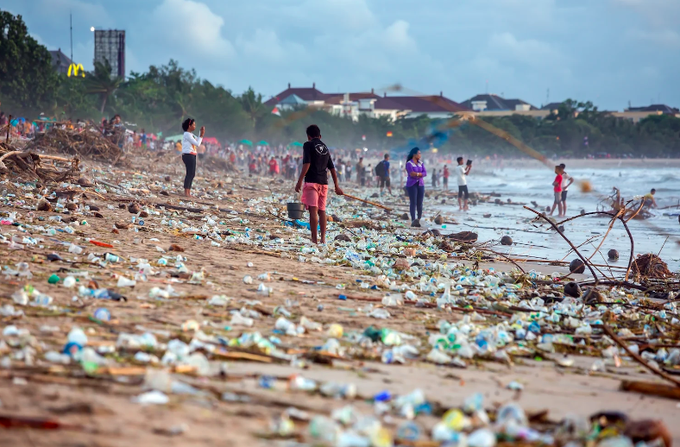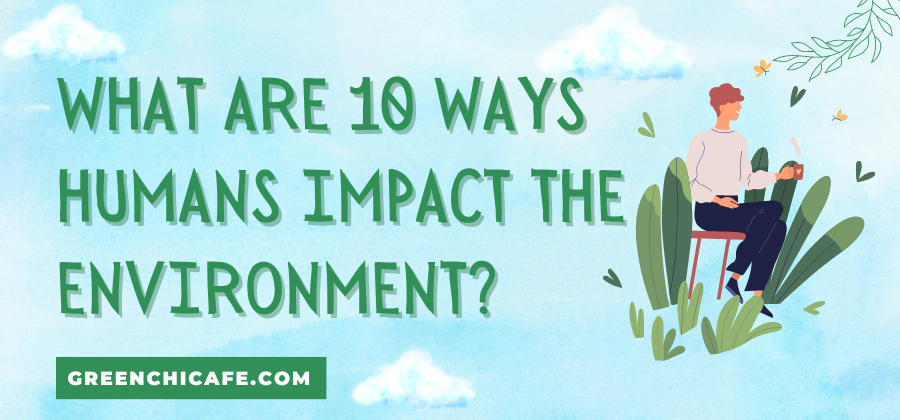Human activity has led to major changes in the environment, from pollution to deforestation and climate change.
Understanding our impact is the first step towards sustainability.
By looking at 10 major ways humans impact the environment, we can gain awareness of our ecological footprint.
What are 10 ways humans impact the environment?

Humans have a significant negative impact on the environment in at least 10 major ways, including pollution, deforestation, climate change, biodiversity loss, and more.
Our actions are altering the planet’s natural systems and causing substantial damage.
Key Points
- Humans are responsible for increased rates of species extinction and habitat loss.
- Burning fossil fuels emits greenhouse gases, driving climate change.
- Agricultural practices like pesticide use degrade land and water quality.
How does pollution affect the environment?

Pollution is one of the most visible effects of human activity.
We introduce large quantities of materials into the environment in ways that negatively affect it.
Air pollution comes from burning fossil fuels that emit gases like sulfur dioxide, carbon monoxide, and nitrogen oxides into the atmosphere.
Water pollution can occur when rain carries these air pollutants into water systems.
Other water pollutants include sewage, fertilizers, and industrial chemicals.
Pollution has many negative impacts, from human health effects to disruptions in ecosystem functioning.
Reducing pollution involves transitioning to clean energy sources like solar and wind.
We can also change agricultural practices to decrease fertilizer runoff.
Simple daily choices like walking more and driving less make a difference.
Overall, being aware of our contributions to pollution is the first step to mitigating it.
Does deforestation hurt the planet?
Deforestation, or clearing forests for human use, is another major way humans change the environment.
Forests are clear-cut for lumber, cattle ranching, mining, and oil drilling.
This leads to habitat loss for millions of species.
Trees also absorb carbon dioxide, so deforestation disrupts this important ecological service.
Deforestation accounts for 12-20 percent of global carbon emissions.
Preventing further deforestation is crucial for mitigating climate change.
Sustainable forestry practices can help, like selective tree harvesting.
Preserving old-growth forests also maintains connected wildlife corridors.
As consumers, we can reduce our paper use, buy sustainable wood products, and minimize meat consumption given cattle ranching’s role in deforestation.
How does climate change impact the Earth?
Climate change is an existential threat to humanity.
Human activity like burning fossil fuels releases greenhouse gases that trap heat, causing global temperatures to rise.
Effects include sea level rise, flooding, droughts, and extreme weather.
Climate change leads to biodiversity loss, ecosystem shifts, coral reef death, and more.
The main solution is rapidly transitioning energy systems away from fossil fuels. Individuals can drive less, switch to renewable energy, and eat less meat.
We can also contact elected officials to advocate for climate policies.
Our choices determine whether the planet remains livable.
Does species extinction matter?
The current global extinction rate is 1,000 times higher than natural background rates.
Humans have caused the loss of over 500 land vertebrate species.
Extinction has many causes, including habitat loss from agriculture and development.
Climate change, pollution, overexploitation, diseases, and invasive species also contribute.
Losing animal species weakens ecosystems, interrupts food chains, and reduces biodiversity.
Healthy ecosystems depend on a diversity of plants and animals.
Preserving habitats and limiting land conversion protects species.
We can support conservation organizations and advocate for endangered species protection. Our daily choices as consumers matter too.
Being ecologically conscious consumers reduces our impact on threatened species.
How do pesticides harm the environment?
Pesticides are chemicals used to control pests and weeds but they often affect more than their targets.
They contaminate soil and groundwater supplies, harming ecosystems.
Pesticides also impact non-target species through direct exposure and residues in water and food sources.
Exposure affects the reproductive, immune, and nervous systems of wildlife.
DDT led to eggshell thinning in birds of prey, causing population declines. Neonicotinoids have been implicated in pollinator collapse.
Adopting organic agriculture reduces pesticide use by eliminating synthetic chemicals.
Consumers can choose organic produce to reduce exposure and advocate for policies that protect pollinators.
Being informed about pesticides empowers us to make eco-friendly decisions.
Do plastics impact the planet?
Plastics are durable, lightweight synthetics that generate microplastics when degraded.
Microplastics have spread across the globe, even to remote regions and the sea floor.
They disrupt hormonal systems and can be mistaken for food, leading to death.
Plastic also kills marine life through ingestion and entanglement.
Much of the plastic waste in our oceans is from single-use consumer plastics.
Reducing our reliance on unnecessary plastics limits plastic pollution.
We can start by using reusable bags, food containers, straws, and water bottles.
Refusing single-use plastics makes a real difference.
Biodegradable alternatives help too.
Most importantly, reducing overall consumption cuts plastic waste off at the source.
How does agriculture change the environment?
Industrial agriculture enables feeding billions of people but with environmental tradeoffs.
Pesticides, chemical fertilizers, irrigation, monocrops, and heavy machinery degrade land.
Soil erosion and fertility decline are major concerns.
Livestock farming also requires vast grain and water inputs.
Agriculture occupies over 40% of the global land area.
Expanding agriculture drives deforestation while mechanization threatens biodiversity.
Sustainable techniques like crop rotation, polycultures, and organic practices reduce agriculture’s footprint.
Consumers can choose local, organic, and grass-fed options.
Innovations like vertical farming and hydroponics optimize land use.
Ultimately, reducing food waste and overconsumption makes agriculture more sustainable.
Do invasive species threaten native ecosystems?
Invasive species establish and spread rapidly outside their native range.
They disrupt local ecosystems by competing with native organisms for resources.
Invasives may prey on native species or change habitat conditions.
Effects include population decline among natives and even extinction.
For example, kudzu overtakes native vegetation across the southeastern U.S.
Invasive Burmese pythons in the Everglades threaten many small mammal populations.
Transporting non-native organisms spreads invasives to new ecosystems.
Climate change also enables range expansion as regions get warmer.
Preventing introductions requires regulation, monitoring, and education.
Where invasives become established, ecological restoration supports native biodiversity.
Being informed about invasive species helps us avoid accidentally spreading them.
How does urbanization impact the environment?
Urbanization, the growth of cities and suburbs, profoundly alters environments.
Buildings, roads, and infrastructure replace green space.
Urban runoff from paved surfaces causes water pollution.
The urban heat island effect raises temperatures.
Cities fragment habitats, reducing connectivity.
Urbanization disturbs hydrological systems and nutrient cycles.
Loss of vegetation decreases biosequestration and evapotranspiration.
Higher nighttime lighting disrupts nocturnal animals.
Cities also have high resource demands, waste outputs, and concentrated greenhouse gas emissions.
Sustainable urban planning integrates green infrastructure to mitigate environmental damage.
Rooftop gardens, urban farms, green corridors, and wetland restoration enhance livability.
Cities can harness renewable energy, expand public transit, and build sustainably.
Conscious consumption and waste reduction add up at aggregated city scales.
Overall, smart growth principles help urban areas minimize their footprints.
Does overpopulation strain the planet?
The world population recently surpassed 8 billion, putting immense pressure on global ecosystems.
More people require more food, water, energy, land, and resources.
Expanding agriculture and development to support growing populations destroys habitats and emits greenhouse gases.
Overpopulation also leads to elevated pollution and waste levels.
Much of the overconsumption and fossil fuel dependence in the developed world relates to population size.
Basically, a crowded planet intensifies every way humans impact the environment.
Family planning, education, and women’s empowerment can stabilize populations.
Increasing efficiency and reducing waste in how we use resources allows us to tread more lightly.
Curbing overconsumption can significantly mitigate our ecological impact regardless of population size.
The number of people on Earth gives perspective on sustainability, but our choices ultimately determine our footprint.
Is climate change man-made or natural?
The current climate crisis is overwhelmingly caused by human activity rather than natural variations.
Burning fossil fuels emits heat-trapping greenhouse gases like carbon dioxide that are unnaturally spiking global temperatures.
The planet has warmed by 1.8°F since 1850, with the majority of warming occurring in the last 40 years.
This rapid temperature increase correlates directly with the Industrial Revolution’s surge in fossil fuel emissions.
Humans have increased the atmosphere’s CO2 concentration by over 40% relative to pre-industrial levels.
No natural factor explains this dramatic rise.
Solar activity and volcanic eruptions cause cyclical heating and cooling effects, but human emissions have entirely overwhelmed these natural forcings.
The UN Intergovernmental Panel on Climate Change definitively concludes that human influence has warmed the climate system.
Without steep reductions in greenhouse gases, we face catastrophic planetary heating.
What is the biggest threat to the environment?
Climate change is the most severe existential threat facing the planet’s environment and its inhabitants.
If unchecked, global warming will fundamentally alter Earth’s climate, rendering large regions uninhabitable.
Sea levels could rise over 20 feet, submerging coastal cities and island nations.
Extreme weather like droughts, floods, and Category 5 hurricanes will become more frequent and destructive.
Millions of plant and animal species face extinction as habitats shift and ecosystems unravel.
Crop failures, famines, infectious disease spread, and water scarcity will impact hundreds of millions of vulnerable people.
Climate change exacerbates all other environmental problems like pollution and biodiversity loss.
Transitioning global energy systems away from fossil fuels is imperative to avoid climate catastrophe.
How does human activity negatively affect the ecosystem?
Human actions destabilize ecosystems in myriad ways, from direct habitat destruction to disruptions of nutrient and water cycling.
Deforestation for agriculture eliminates plant and animal communities while fragmenting the remaining habitat.
Dams and water diversions heavily alter hydrologic regimes that species depend on.
Overfishing collapses food webs and depletes breeding stock.
Pollution poisons environments, as with fertilizer runoff creating dead zones devoid of oxygen.
Invasive species outcompete natives, facilitated by global trade.
Climate change forces range shifts that Species can’t adapt to quickly enough.
Intensive resource extraction degrades land.
Basically, human infrastructure and resource demands degrade natural systems that maintain biodiversity and ecological balance.
Reducing our environmental footprint is key to minimizing ecosystem harm.
Key Takeaways:
- Human activities like burning fossil fuels, deforestation, and spreading invasive species have caused substantial environmental changes.
- Loss of biodiversity, pollution, and climate change now threaten the planet. However, understanding our impact puts us in a position to make changes.
- Our choices add up, from supporting conservation policies down to everyday actions like biking instead of driving.
- An aware and engaged populace gives hope that we can redirect human ingenuity to benefit the environment.
- By knowing the ways we affect the world, we gain the power to reduce our ecological footprint.
FAQ
How does transportation affect the environment?
Transportation, especially cars and airplanes, contributes significantly to air pollution and greenhouse gas emissions through burning fossil fuels. Walking, biking, and public transit are more eco-friendly ways to get around.
Do electronics have an environmental impact?
Electronics require energy and rare earth metals for production. They also create e-waste, which can release toxins when landfilled. Reducing electronics consumption and recycling properly helps minimize their footprint.
How do chemicals and toxins harm ecosystems?
Chemicals like DDT and PCBs accumulate in the environment, harming organisms through biomagnification up the food chain. They disrupt reproduction, development, and immunity in wildlife. Proper chemical disposal prevents ecosystem contamination.
The writers at GreenChiCafe are passionate about the environment and our natural world.
Please check out our website for more great content on living sustainably.
